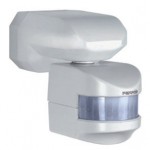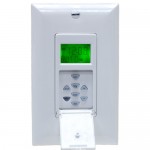How to control lighting has a lot to do with new electrical codes, preference and efficiency. New electrical codes require occupancy sensors to control any inefficient lighting (Incandescent or halogen) in your bathrooms, laundry rooms and garages. Dimmers are required for any inefficient lighting in all other rooms of your home. Other common lighting controls are listed below.
Dimmers reduce the wattage used as you dim your light level down. Not only are they required by code in many ares of your home; they also are great for controlling light levels as needed.Motion detectors, similar to occupancy sensors are used for outdoor lighting, typically for either security or convenience. These sensors detect motion and turn on automatically, they stay on until the programmed time has elapsed.
Occupancy sensors activate lights when a person walks into a room automatically, and are programmed to shut off after so many seconds or minutes have elapsed, depending on programming. As mentioned above, occupancy sensors are required in bathrooms, laundry rooms and garages for inefficient lighting.
Photocells are used to turn exterior lights on at dusk, and off at dawn. They are often used in conjunction with motion sensors; this is so the motion sensor doesn’t turn on lights during the day. These two sensors are wired in series, power comes into the photocell first, and depending on if it’s light or dark outside, the photocell will either allow, or not allow power through it, and onto the motion sensor. If the motion sensor doesn’t have power coming into it, it can’t do it’s motion sensing capabilities which keeps lights from turning on during the day.
Remotely controlling lights, fans and other devices in your home can be done by wiring in a transmitter to either a single, or multiple lights, fans or other devices. Using a remote control to dim the lights and start a movie, all without leaving your seat. Turn lights on or off from outside your home, whether you’re in your car or out for a walk.
Time clocks come in either digital or mechanical styles. The advantage of digital is how small they are, they fit in a standard switch or outlet box. Be careful when selecting a digital timer, only some digital timers work with fluorescent and or LED lighting. Using photocells in conjunction with timers is a great way to control your exterior lights. The advantage to having a photocell wired in conjunction with a timer, is that you don’t have to adjust the time on your timer several times a year as the sun begins to set and rise, earlier and later in the evenings and mornings. Even though the timer is sending power out, the photocell will not allow power to the light fixture until the sun has gone down in the evening, and will shut off power to the light fixture in the morning as soon as the sun comes up. Your timer can be set for 5:00 PM to 7:00 AM all year long.





